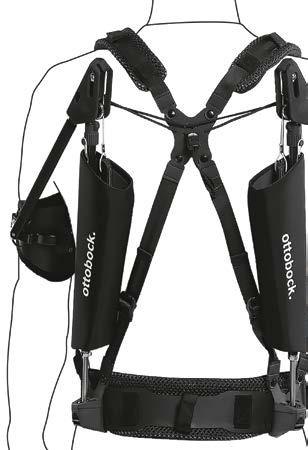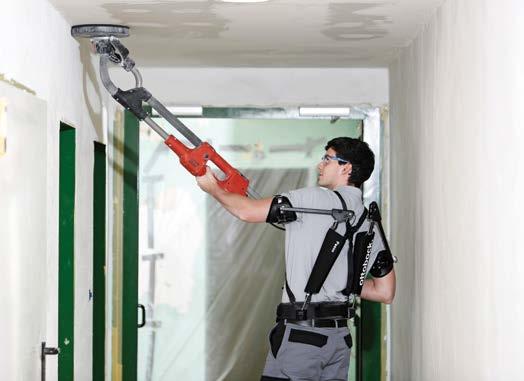
5 minute read
Health and Safety
Outside help German-designed Paexeo Shoulder exoskeleton is helping reduce staff turnovers – and the construction industry is taking note
Leading German medical technology company Ottobock is revolutionising the capacity for manual overhead labour with innovative wearable tech body suit, the Paexo Shoulder exoskeleton, which could provide major benefits when it comes to the Australian construction industry.
Advertisement
The upper body exoskeleton, which is now being used in 500 plants and factories worldwide, recently launched in the Australian market following its initial release in Europe 18 months ago. There it has already been snapped up by leading businesses in the construction and internal fit-out industries.
The exoskeleton was designed to relieve muscular stress for workers who specifically spend long periods of time working with their arms raised. When people wearing the Paexo Shoulder raise their arms, pads around the biceps transfer weight to the hips thanks to mechanical cable pull technology.
It provides noticeable relief for the muscles and joints in the shoulder region. This makes it particularly beneficial for people such as plasterers, painters, electricians, builders, assembly line workers or anyone else in the construction, general maintenance or repair fields, required to do intricate or repetitive tasks overhead.
German company Thor Industries GmbH & Co. KG which provides qualified staff for the household, building and supply technology sector was one of the first companies in Europe to use the Paexo Shoulder exoskeleton. The company, which has around 1,000 employees, is known for being extremely loyal to workers and in 2012 was named one of the top 100 employers amongst German SMEs.
With people now living on average well into their 80s and beyond, and retirement age increasing, the issue for many companies such as Thor is how to retain and support staff as their health needs change, particularly those specialising in manual tasks. One of Thor’s prime objectives is to keep staff turnover as low as possible, in part by ensuring the highest levels of health and safety.
“Our employees were delighted by the way the exo immediately relieved strain on their muscles, for example during overhead welding or electrical installations under ceilings,” said Thor CEO Kersten Thor.
“Exoskeletons also make jobs in industrial assembly more attractive. They can increase employee loyalty and help us recruit new employees.”
A former heating engineer, Mr Thor worked for years as a temporary worker on assembly. Wanting to improve working conditions for those in the temporary employment industry, he has been on a mission for 20 years to improve conditions for workers, whether it be bad pay, poor treatment or inadequate working environments.
The company has long ensured that employees have perpetual contracts, performance-based pay, over-the-counter allowances, free weekends, and monetary incentives and awards. Mr Thor, who was also awarded Entrepreneur of the Year in 2013, said, understanding how employees perceive their working environment is vitally important for any business going forward in a fast-paced market.

As far as productivity goes, the company believes it’s vital to guarantee Thor employees can work independently and efficiently, hence their interest in the Paexo Shoulder exoskeleton.
The suit does not need an energy supply, so it can be donned within a moment’s notice without the need to power up. Workers wear the Paexo Shoulder close to their body, similar to a backpack. It provides mechanical support for individual body segments in certain postures and movements through the interplay of springs or elastic bands. This type of preventive relief could reduce the risk of work-related musculoskeletal disorders in the shoulder region over the long term.
In Australia, these disorders are a common cause for inability to work and are a significant cost for companies and healthcare systems. Safe Work Australia reports 60 per cent of all serious claims between 2009-2010 and 2013-2014 were related to musculoskeletal disorders (MSDs) affecting areas such as the joints, vertebrae, muscles and tendons. Some 76 per cent of injuries relate to MSDs.
Lotte Koenig, Sales & Business Development Manager Australia, said apart from the construction, general maintenance and repair industries, the Paexo Shoulder has great potential to increase productivity and support workers from a very wide variety of industries in Australia such as all aspects of manufacturing industry including ship building, automotive and rail; farming and agriculture; food processing; and engineering.
“Paexo Shoulder is especially lightweight – in fact, it is the lightest exoskeleton of its kind, weighing in at less than two kilograms,” said Ms Koenig.

“As the design is based on natural human movements, users can walk, sit and also pick up objects with it. The suit can be worn comfortably for an entire shift, or parts of it, while providing noticeable relief for shoulders and arms during overhead work.”
“It also comes in an adjustable one size fits all model, so there’s no need to buy different sizes. This means each company has full flexibility when the exoskeleton is needed in different departments,” Ms Koenig added.
Retailing for $6,900, the Paexo Shoulder launched in Germany in 2018 after six years in development with Volkswagen. It is now in international use across many different countries including most countries in Europe, the US, Canada, Mexico and India.
The use of exoskeletons in general is expected to become more commonplace in the future in workplaces given high injury rates. Safe Work Australia reports that musculoskeletal disorders are highly prevalent in the Australian population affecting 6.9 million people between 2014-2015 according to the Australian Institute of Health and Welfare.
For Australia’s workforce, work-related musculoskeletal disorders (WMSDs) are the leading work health and safety problem, both in frequency and cost which in 2012–13 totalled more than $24 billion.
Given the need for our increasingly ageing workforce to remain healthy and productive, implementation of more effective workplace risk management practices to reduce WMSD risk is increasingly urgent. Whilst musculoskeletal disorders may result from a single event, more commonly they arise from cumulative exposure to one or more hazards over an extended period.
Many of these issues are caused by manual material handling tasks, which include lifting, lowering, holding or carrying loads. Twisting, bending and overhead work also increase the risk of a work-related disorder, decreasing productivity.
Situated in the German city of Duderstadt, south west of Berlin, Ottobock has been responsible for several innovations in prosthetics, including the C-Leg, a computerized knee that adaptively varies its passive resistance to suit the patient's different walking gaits, and the Michelangelo Hand, a fully articulated robotic hand prosthesis. Ottobock has also been a partner to the Paralympic Games since 1988, and an international worldwide partner to the International Paralympic Committee since 2005.
The Ottobock Paexo product range also includes neck and wrist supports. The company will also be launching a muchanticipated back support exoskeleton in 2020.
For more information, please visit:
www.paexo.com











